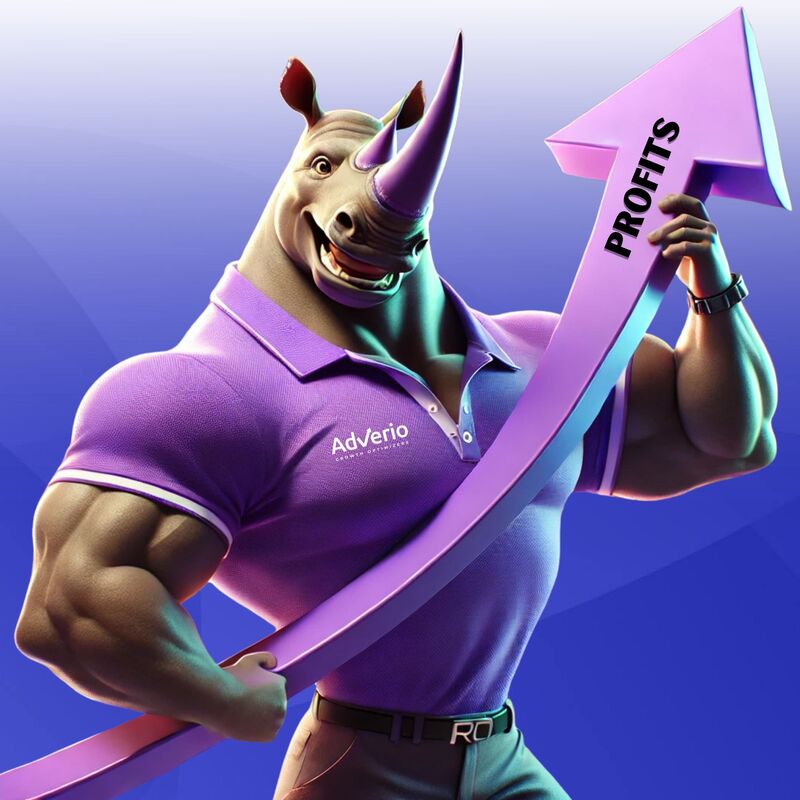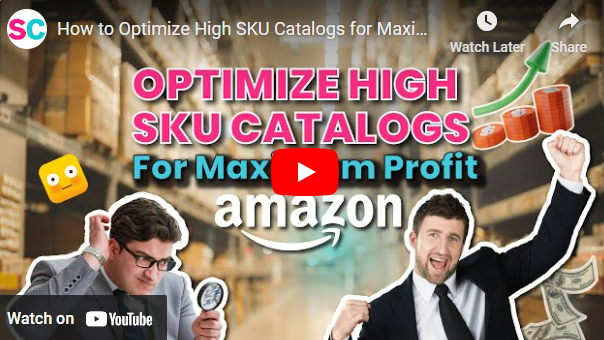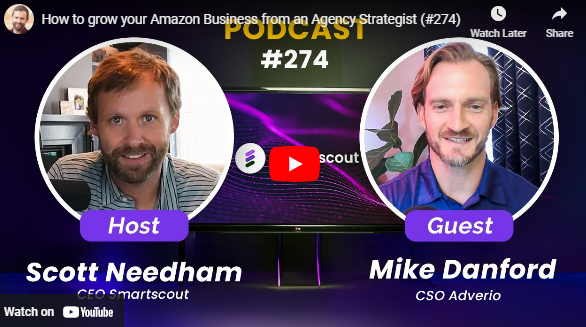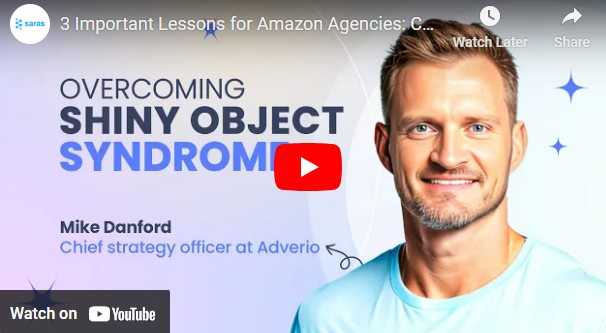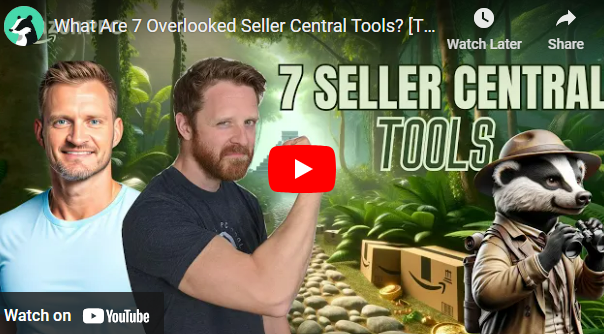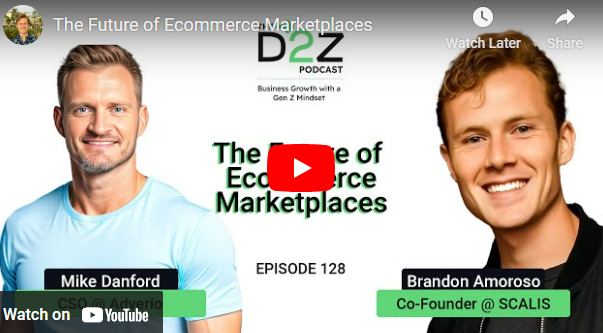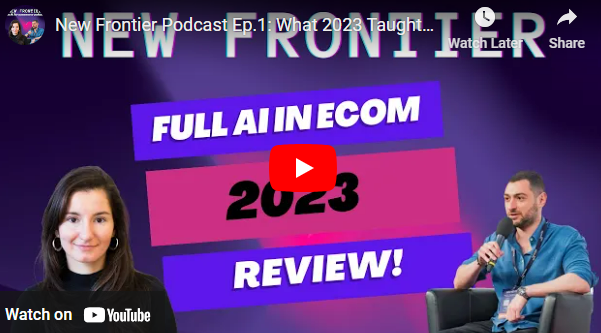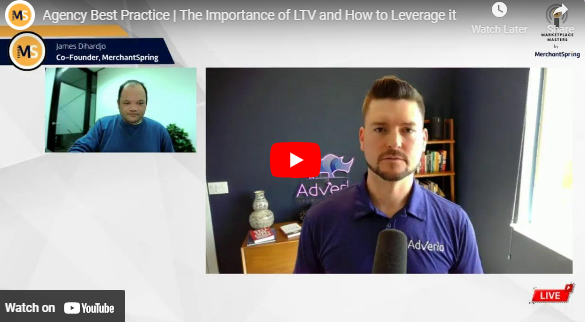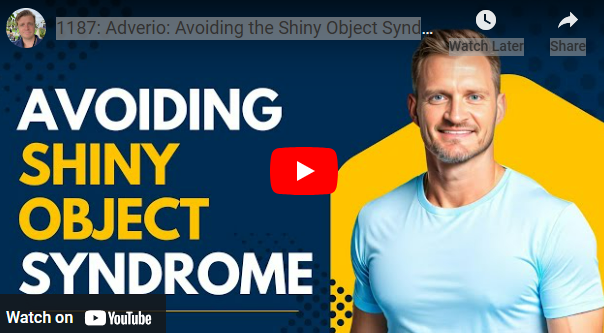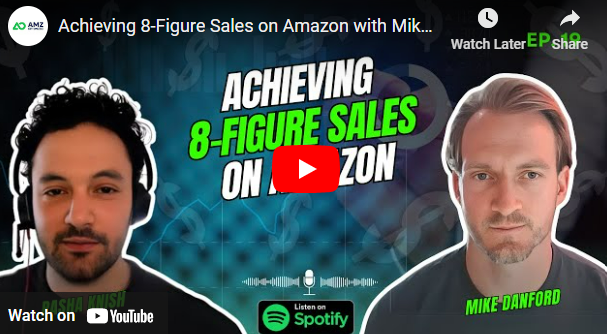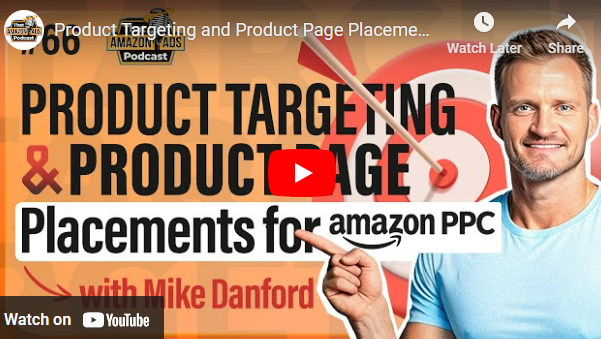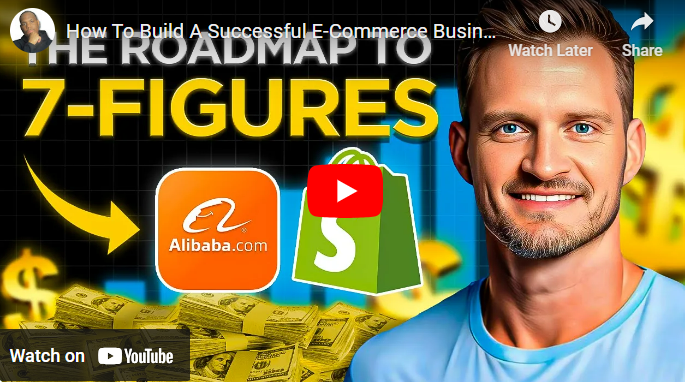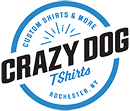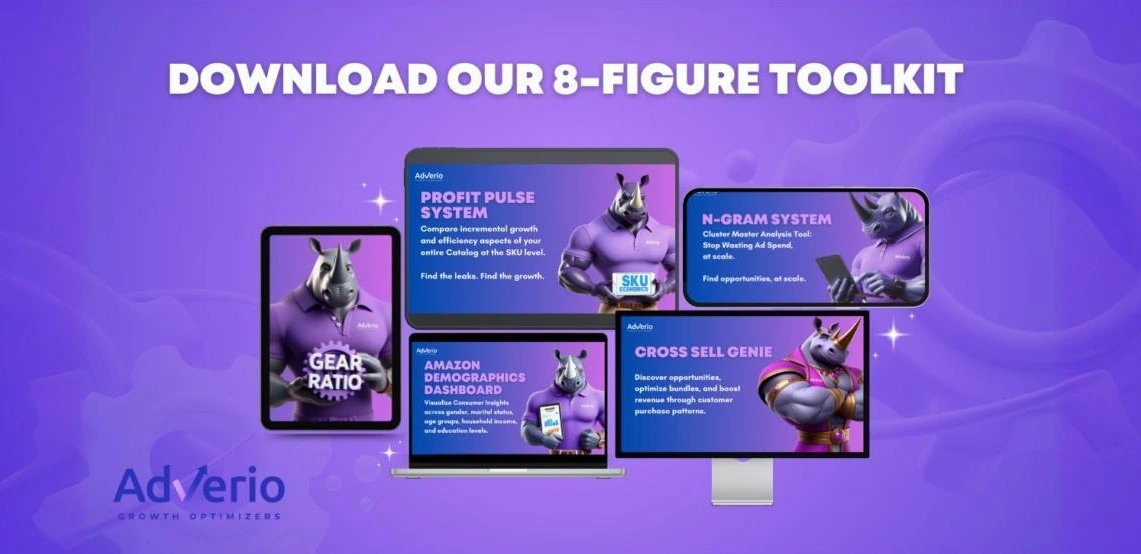Robert Plank Marketer of the day
Get Daily Insights from the Top Internet Marketers & Entrepreneurs Around the World
The sheer volume of data in e-commerce can be overwhelming, especially when you’re constantly trying to keep up with shifts in platforms, advertising strategies, and pricing models. It can feel like you’re always adjusting to new trends or technologies, which makes it tough to stay focused on what truly matters for your business. Sorting through all this information and figuring out what’s most relevant can take up a lot of mental energy, leaving you wondering if you’re missing something crucial.
Mike Danford is an expert behind Adverio, a company that specializes in helping e-commerce brands solve the difficulties of large-scale catalogs and unlock their full growth potential. With a deep understanding of data analysis and the strategic application of AI, Mike has developed a proven approach to reviving underperforming products and driving sustainable revenue growth for his clients.
- 00:08 – Scaling e-commerce through data-driven strategies and AI optimization.
- 02:06 – Utilizing AI in e-commerce requires careful data management.
- 05:36 – E-commerce brands must adapt pricing strategies amid increasing competition.
- 07:34 – Optimizing pricing can enhance sales velocity without additional advertising spend.
- 11:03 – Brands should revamp and retest old products for new opportunities.
- 12:51 – Transforming underperforming brands into thriving businesses.
- 16:26 – Utilizing referrals and podcasts to expand client base and provide valuable resources.
- 18:01 – Prioritizing personal connections over digital interactions in e-commerce.
- 21:20 – Focus on strategic macro levers for effective e-commerce growth.
- 22:55 – Optimize your e-commerce strategy by leveraging data and tools for better decision-making.
- 26:14 – Leverage shared tools and practices to avoid shiny object syndrome in e-commerce.
- 27:53 – Focus on simplicity and efficiency to avoid distractions in e-commerce growth.
[00:00:00] Robert Plank: Hey, welcome back. Mike Danford is on the podcast from Adverio. That’s A D V E R I O dot I O. And we are going to be discussing e commerce, specifically large scale catalogs and breaking through those revenue plateaus, scaling strategies, getting into untapped markets. So Mike is here because he knows his stuff.
And if you’re someone who is in the e commerce space and you want this kind of done for you, start to finish. happening, then mike is h you what he’s seen, the d mindset, how to take action more. So mike, glad to be Thanks so much for having me.
[00:00:48] Mike Danford: Looking forward to it.
[00:00:50] Robert Plank: So am I. And so we did our best to introduce you, hype you up for the audience, read you bio, but in your own words, straight from the horse’s mouth, what are you focusing on?
What has you energized, excited, fired up?
[00:01:01] Mike Danford: Oh, that’s a, there’s a lot. So obviously professionally, you know, as mentioned, we work with large catalogs, kind of understanding, um, how to navigate that in each marketplace has a different set of data that they’ll release and different way of presenting the data.
So you kind of need to really understand how to clean it and, uh, Clean it up and present it in a way that makes the most sense for your brand and whomever you’re working with. So you can make educated decisions. And then obviously the last probably year and a half or so, then we’re in the, you know, AI agentic, um, hat as well, since we have such large data sets, it’s how can we do more with less and how can we, you know, put our team and supercharge our team to allow them to have more data driven.
Uh, decisions, et cetera, and to also help with, you know, standardizing that, making sure there’s consistency, uh, in the mechanics behind the scenes. So we can, we can, um, keep those results on repeat from new brands.
[00:01:53] Robert Plank: Well, wonderful. I’m excited to jump in and and talk about some of that stuff and wake some people up and get them realizing what is possible and what they perhaps should be focusing on.
And just from like a, like a high level perspective, right? You mentioned about AI. And I mean, a lot of us use AI every single day, you know, for like copywriting, writing, things like that. And, uh, and many times I’ll like run through my whole database. I’ll be like, Hey, I need to like generate like personalized emails to send to people.
So many times the work is in, like, fitting the pieces together, right? I’ll be like, well, here’s this data source that goes through that, and it, you know, runs this through the Zapier, and there’s this spreadsheet, and this kind of custom coding. And it seems like that’s kind of the, the headache, the hassle, the bottleneck of being like, well, it can do all these amazing things, but you have to have, like, the input just right, and the, the JSON output, and they can grab this one key and put it in the right thing.
And there’s a lot of ways to go wrong. I definitely. Uh, relate in like kind of a different context of trying to make sure that the data is clean and that you have like this fire hose at your disposal, but you have to, you know, pointed up at the fire, right? You have to use it properly. Uh, but I mean, tell me about the challenges that you see.
So like, you know, all these things are available, uh, with e commerce and, um, even as a lay person, like I know that, uh, you know, anyone can plug in the Amazon or Walmart, but even just saw looking at your website just now, like. Hey, we can be listed at Target. Who knew, right? They all have these different systems.
And so what’s happening right now in the e commerce space? Where are people succeeding? Where are they failing? What are the challenges?
[00:03:23] Mike Danford: Yeah, I think that 2024 had a different set and 2025 will have its own set of challenges. But for the last year or so, certain platforms, and I’ll speak more to Amazon here, have To release more data, uh, than they have historically.
I think since any Jassy has been in, uh, there’s been some pretty, pretty significant changes on the backend and it’s, you know, helping our brands understand, you know, stay away from object or shiny objects in their own words, you know, anything that comes out, you have to use it and understand that. And then we’re able to leverage since we manage so many different brands that, hey, uh, we’ve already tested this a couple of times.
There’s no, no need to do that. Or, hey, we’ve tested it and refined it. And here’s the best way to go to reduce your learning curve. And it’s really just not being afraid to try new things, but also not letting that, um, you know, overturn, you know, or, or overrule anything you had existing for your quarterly goals, annual goals, et cetera, and just trying to figure out how to integrate that.
And I’ll segue into the AI piece as well as AI is out there. It’s been out there for years. Um, for us, we started in, it was more of a bidding, a very simplistic, um, models. And now it’s a lot more, um, you know, alphanumeric text. You can get outside of just the numbers. You can get into images and scans and so much more.
And to your point, it’s about. The, the brands that can lean into it and embrace it and learn how to leverage it are the ones that are definitely putting a gap between the other brands that are a little more, Hey, I don’t really want, I don’t like AI, my wife, you know, she’s anti AI, but I’m like, Hey, you got to understand how it works.
Or it’s going to take over certain parts and you’re going to be left behind. It grows. It’s advancing at such a pace. And so the brands that are at least getting familiar with it, getting comfortable with it and trying to understand, you know, Hey, here’s what we do. Yeah. How can we, how can AI help us do it better, faster, or both?
Um, if they’re, if you’re asking those questions and I think they’ll, they’ll say with the curve or ahead of the curve. Um, again, we see brands that kind of fall to the wayside pretty quickly of, Hey, you’re not running this, you’re not doing this. Um, you can’t keep up with this because you have such a large catalog.
Here’s a way to go through. AI can give you some ideas at large data sets that a human would take hours and days and weeks to do. Think about it that way. And after injecting that in their daily operations, to your point, it used to be just kind of a copy machine, copywriting. Now there’s so much more that it can do.
It can automate those processes. It could be a, uh, a sounding board for way more than just copywriting or images, et cetera. Um, so that’s, that’s where I think it’s going. And then for, for 25, we’ve, for us in our space, the advertising and marketing section is, is getting more saturated, both in terms of volume of sellers on each platform, and then there’s different, there’s new ad types, et cetera.
So it’s really being able to integrate that, but everyone is now is essentially using some form of, you can call it SAS or some way of. Optimizing bids, optimizing placements and, and certain things in the ad side. So it’s getting more competitive. People are more reactive. It’s really hard to take over and squeeze out that extra incrementality, um, at a macro level.
However, we’re seeing a pretty big gap where a lot of brands are still not testing their pricing. So they’ll, if you only own one platform or you have a few and you can allow Amazon to be your, your North star where all the other prices kind of follow Amazon. Then you can, there’s a lot more juice out there.
If you can learn how to make micro adjustments on it, how to lean into your low conversion days versus your high conversion days or around what we call tent poles or sales events. I feel like that’s where one we’ve been testing for the last year or so and, and have at scale, um, again, AI helps with that, uh, rules automation and being able to, um, look at what the market’s doing as a whole, also understanding what your competitors are doing and being.
Willing to say, Hey, our competitor dropped by X percent. We don’t want to drop below that. So let them have their little cells pop right now and what we’ll take over later and making those decisions. But again, it feels like the bidding of advertising maybe five or six years ago is kind of where we’re at with the bidding of our prices and understanding how to do that and being sure not to make too large of changes so that you don’t get delisted and kind of blocked out of the buy box, et cetera.
But. The micro adjustments there, we’re seeing at 2 to 3 percent margin for a lot of brands, a pretty consistent, um, some or more if they haven’t touched their prices in years or et cetera. It’s also a way when we connect to a brand, you know, we work with large brands, so they’re going to have A, B, C, D tiers, et cetera.
Um, in the bottom part of their catalog, maybe it doesn’t make sense to run advertising. So let’s test your pricing. Can we just, the only thing we change is your pricing. Um, what does that do? Is there a potential for that? Um, et cetera. And a lot of times that gets to some of the slow movers moving at least to some normal, uh, velocity, making you liquidate or get rid of some of the stuff that’s been sitting on shelves.
And so that’s nice to not have to spend more in order to find out if it’s going to sell more. You can just kind of, um, optimize price, et cetera. So that’s what we’re looking at right now. Obviously other brands would be, there’s a lot of options, but. That’s what we’re looking for right now, at least the first half of 25.
[00:08:20] Robert Plank: I love it. Well, that’s a heck of an answer. And it’s like there’s these huge problems and some of those problems contain some problems. But what I’m getting from you saying this is how important it is to think and to have that kind of human strategy and and be like, okay, well, here’s this whole catalog.
And maybe. There’s like the, that D tier of what’s in there and we can get it selling. And it just takes a little bit of a nudging, right? Just kind of apply some of the AI juice. And so I like a lot of what you’re mentioning here of how you say, well, there’s the like, kind of like the, the pricing, the bidding bots, and you don’t just let it lose.
You say, well, Hey, we’ll go ahead on this level. And I forgot, like you said, if our competitor is doing this sale, like let them have their sale, but don’t let them drag us down with, with them. And then. As far as like AI, like it’s, it’s so easy for it to drive you crazy, right? As far as like all the possibilities.
And so you’re saying, well, uh, it gives, gives you a lot of stuff and just kind of use it to help you or like look at the small percentage of the results and to maybe say, well, it would take a person. 10, 20 days to do all this work. Let’s just have like figure out what our goal is and what, and how the AI can help us get there.
So it’s not like it’s like doing anything like crazily new. It’s just like shortcutting the, all the time it would take a person to like, you know, crunch the numbers on some of this data. And so you work at these, these huge brands, these huge catalogs. Is there usually, like, something that is, like, wrong, like, with a lot of them?
Like, you mentioned, like, the prices, the bids, like, what’s, is there, like, a common mistake that you see these brands doing in e commerce these days?
[00:09:54] Mike Danford: Yeah, there’s a few, so I’ll answer it with at a high level that a lot of brands will test a product in terms of development or advertising or marketing, labels, whatever it may be, and, and they’ll go to market and they may try it for three, six months, maybe longer, depending on how they did their inventory and how their R& D is set up and let’s say it doesn’t do well and they’ll just kind of let it sit there and they want it.
Retest it later. It’ll just kind of sit there, but it’s a small amount of inventory. It doesn’t really bother them. It’s not costing them, et cetera. Uh, but so we routinely will come in with brands and Hey, like we mentioned earlier, a little bit of advertising behind it, there’s a lot of cheap clicks out there, a little ways, just to kind of get some extra traffic to it that’s relevant and see what happens, uh, based on where you’re at before we even kind of, uh, improve or optimize your listing.
And then obviously there’s pricing as well. And. A lot of times that’ll do it. So one of our favorite things is, is we tell a brand two things. One, Hey, are you prepared for, you know, can you, can you handle the marketing kiss of death? Can you handle a X number of lift and your, you know, units, products, et cetera, make sure they’re prepared for it because we’re not used to it.
And the second part is one of my favorite is usually about six months in they will, they’ll finally be, you know, comfortable and we’ve seen everything and there’s a lot of things going in different directions and you can kind of see where everything’s going and they’ll be like, Hey, we are selling this product that we haven’t sold in 10 years, or, Hey, you’re selling a product that, you know, now it’s in our A tier that we’ve never been able to sell.
Um, so it’s, it’s great to see products that were maybe considered dead or not viable and to be able to revamp them or just try it differently. And all that’s to say that that’s what our brands need to be. Not afraid to do that, not afraid to re-test it. I mean, the market changes daily, weekly, monthly, annually, every couple of years, et cetera.
Well, you may have been too early to the, to the market for that particular product or a a, a style or a type of thing. It may be a couple years before it becomes back, uh, to being popular. All it takes is an influencer, two influencer or two or a couple to more than that and to get into it. And it takes off.
We see products like that all the time where, hey, we know someone who will like this product. Let’s get it in front of their audience. Takes off. And then the other algorithms on the platform will pick up and piggyback that. Um, and then you can obviously throw more gas on that if you can. So I would say that would be where the biggest opportunity for them, the biggest opportunity for us.
I’m kind of like that they don’t do it because it makes it easier for us when we first work with a brand. Say, hey, there’s a lot of levers you haven’t pulled or a lot of levers you haven’t pulled in a long time. So let’s pull those again. Um, and kind of give a little budget allocation to those, um, in a testing period and then revisit and go from there.
[00:12:31] Robert Plank: I love the method. It gives your client an easy win and wakes them up a little bit. And it’s, it kind of shows the value of having some fresh perspective because no matter what the business is, right, we all have like the new thing that’s got us really fired up. That kind of like B level thing that. It’s maybe like it’s working and it’s steady and it’s making our income.
There’s like the, and then there’s the C and D stuff of like, Oh, well, you know, I feel bad that I’m not focusing on that anymore. Or like, it’s really just kind of gone by the wayside. And for someone like you to come in and like, literally be a magician, right. You get some traffic out of thin air. Talk to those influencers, work your magic and then like get some, get something new moving.
It’s cool just to, you know, break the pattern and do something new. And so I’m looking at your website, right? I have tab open at vario. io and you have like all these different like brands that you helped. Is there like a fun story that you can share with us just to kind of demonstrate the before and after and just give us an idea of what the process is like working with you?
[00:13:34] Mike Danford: Yeah, there’s several in general, the theme is my absolute favorite is a brand will come to us and they’re down 20, 30 percent year over year and they’ve tried things you can see in their history that they are trying to think it’s not just the fact that they’re being stagnant and not looking into things, not aware of it and all of a sudden, you know, the business is down.
Uh, so on repeat, that’s, those are my favorites to work with because we can come in, we’ll vet, we’ll say, hey. Here’s where we think the opportunity is. We’ll give you a total addressable market, uh, potential, uh, for this. Uh, and then we can agree on how much it’s going to cost. Uh, you know, X, Y, Z for your margin, you need to give up for three, six months.
And then, and then we can go from there. And, you know, as I mentioned earlier at the end, that six months, I mean, that my favorite thing is for a brand to tell us, Hey, we’re moving products. We never thought we could. They haven’t moved in a long time, and really that is the most rewarding. There’s a case study on our website, Crazy Dog.
They are absolutely amazing to work with. Uh, Left Text as well. I mean, there’s, there’s seven more I could name, but they, it’s the brands that are, when they come to us, they are. Um, humble and not afraid to admit there’s something wrong or there is a potential to improve upon. And then they get it. They, they are patient.
They understand, uh, that there will be a certain amount of time that they need to just kind of And be in understanding where it is and then being in communication with them. And then, like I said, six months to, you know, a year later, seeing where it is reflecting, um, what’s happened and then being able to pay the, the appreciation back to them and say, Hey, this wouldn’t have been possible without your awesome brand, great products, et cetera.
And your faith in us. And your, and your patience, if we don’t have enough time, you don’t have enough patience and we’re not, we’re not a good fit. So we basically tell a brand in the beginning, Hey, this is not a quick fix. There are quick fixes that we can deploy and we’ll let, we’ll, we’ll obviously do those in the beginning.
But what you’re looking for here, uh, is pretty significant. And, and, and if they can be patient, that’s my absolute favorite. There’s my favorite brands to work with the ones that get it and understand it and are willing to be there and them, they can celebrate the wins with you. Uh, the appreciation goes both ways.
[00:15:43] Robert Plank: I love it. And you know what you’re mentioning here, it, the, the nurturing and the onboarding, I think it’s underrated, right? Because there, there’s always the focus in, okay, what, what’s my, uh, my process here, this client that I’m helping, can’t the clients to kind of drop into my lap. But then there’s the whole, this whole idea of, well.
Someone comes in and how am I going to like lay out a plan and meet with them and make sure that we’re doing the job right and tell them what to expect and do it and kind of check in and show results. It’s like, it’s a different mindset and it’s really easy to ignore all that. Just be like, Oh, you know, I’ll do the work.
I’ll show them some reports. Uh, And so I like how you’re like, well, hey, here’s the kind of the road map. And then when you have this attention to detail, then after the fact, you have these stories like this. And then for the next person, the next company, the next client, you’re like, Hey, this is what I’m looking for.
Like you said, the 20%, uh, year over year decline, like, okay, if someone has that problem, that’s the kind of person I want to help in it. It’s really great to. See the big picture in that way, right? And be like, okay, here’s what leads me to them. Here’s how I bring them through and then here’s how it is the result afterward.
It’s cool to think about and so, uh, as far as like that, that part of your business, right? There’s the doing the work. And then there’s the getting the clients. And so just out of curiosity, like the, um, the getting traffic and getting clients, like what’s your preferred way of doing that? Are you like a, a go on podcasts a lot like this, go to trade shows, run paid ads, like what’s your preferred way of like getting new people in the door?
[00:17:13] Mike Danford: Well, absolutely. I mean, my favorite is, you know, referral, right? A brand that we work with, they, you know, the best ambassador or someone you’re working with currently, those are the favorites, um, and they usually bring, you know, brands that are of a comparable size and like minded individuals. So obviously that’s a great fit for us.
And then, yeah, we’ve been doing the marketing for the podcast marketing for, you know, six, seven months. Uh, it’s been great to connect with folks just like you and different audiences and kind of interact with them. And how can we, we’ve given away a lot of free tools. Uh, that are available on our website.
Uh, so a lot of those will help different audiences that we work with. Even if we’re not able to work with them in their brand. Maybe they’re not a seven figure brand yet. They aspire to be. And these tools and resources can help you understand our methodology and kind of leverage it, you know, on your own.
Um, aside from that, we have, uh, some pretty interesting way. We, I would say we’re a little old fashioned in how we connect. We still like physical connection. Uh, whether that be in, to your point, trade shows, it’s definitely where 2025 is a big portion for us is to be face to face. I love that. I miss that.
I mean, I’ve been in the digital space for a little over 10 years and I, I, I have a background in contractor management, you know, like construction contractor management, and I just miss being able to collaborate and meet and see things in person. Uh, with the different brands and kind of, uh, build that rapport instantly.
It’s a lot easier to do in person than through email and cold, et cetera. So you have other ways. We have, you know, a physical VSL, so video sales letter, but it’ll actually be physical. So they actually pop it up and look at it, et cetera. And then behind me here, there’s a book, Get Different. It’s by Mike Michalowicz.
And he, he is one of the best about think outside the box. Like don’t do what everyone else is doing. We’re our mascots are rhinos. So we’re the purple rhino among all the gray rhinos. So again, it’s just, how can you stand out? How can you connect with the audience? How do you get through all the noise and the gatekeepers?
A lot of these brands have been able to do that. And then where do they hang out? And it changes, you know, every year, the plan is different. Um, you know, it’s, it’s not necessarily newsletters, not cold outbound. It’s, it’s, it’s different ways of doing it. Um, and, and also for us, a big shift is understanding.
It’s not the volume, it’s the quality for us. You know, we have a smaller subset of brands that we can work with and want to work with. So it’s being a little more intimate in our initial connection with them. And we see that go a long way.
[00:19:28] Robert Plank: Very cool. So you’re a hard worker, but you also have the awareness as far as the different methods and what’s working and how you approach them.
And I love Mike McCallow. It’s Motorbike Mike. I had him on this podcast like 10 years ago. I need to go and see what he’s up to nowadays. I always see every couple of years, he’s got some new book out. And so, uh, it’s, it’s great to kind of hit a touch different bases right now. We’ve talked about Who you help and where they need help and what you’ve done to grow your business.
But in our last few minutes of our conversation, because we just now met on this podcast here, Mike, is there a question that you wish I would ask you, but I just don’t know to ask you? Oh,
[00:20:06] Mike Danford: that’s a great question. Uh, no. I mean, I think you’ve asked great questions so far and no, I can’t think of one that comes top of mind right now.
[00:20:15] Robert Plank: Nice. Well, the A plus score for Robert Plank as far as like question within the question inception question. And so since we’ve talked about all these cool things, you said that you have this kind of specific type of business, right? They have to be like at a certain level in order to go to adverio. io.
and start this conversation with you. So who is this ideal client fit? Who should someone be? What size should their company be? And what kind of problems in order to start this conversation with you?
[00:20:45] Mike Danford: Absolutely. Great. Again, great question. So it is typically a mid seven to mid eight figure brand. Um, and ideally they are, they are flat, um, in the last year or two, or they have some kind of decline in the last year or two of their revenue.
One that, what that does for us is the brand. and is willing to work and try to find a solution and how to regain that, um, loss in sales or, or have a new level of sales, a brand, what we found at brands that are already accelerating is you’re constantly battling, whether it’s our efforts or their efforts that have increased or turned things around.
Um, so we found that it’s just much easier. We get to focus on actually driving the results if there’s a very clear, uh, Delta that we can show within 30 to 60 days of working with the brand. Um, again, ideally they’re going to have large catalogs. We are, we call ourselves, you know, we’re soft lines experts.
So think. Textiles, bedding, apparel, uh, footwear, um, clothing accessories, anything of that nature. High, high multivariate where you’ve got multiple sizes and colors of the same product. There’s a lot of unique tactics to go to that. Obviously that makes your campaign set much higher and you have to be more strategic.
You also have to Look at it through a macro lens. Sometimes you’re not, because you have such a large catalog, you’re not able to pull all those little bitty tiny levers that everyone’s telling you, you know, this guru and that guru saying do this, do this and do that. They help, uh, but they don’t, not at the level for a large catalog.
It’s all about being able to pull those macro levers and have the big deltas as quick as possible.
[00:22:14] Robert Plank: That’s a great insight at the very end there, that we might hear about some guru say something that’s like, oh, well, that that’s exciting. I need to implement that. And someone like you might say, well, it did that guru mentioned it because it’s new or it’s something that they’re doing.
Is that appropriate for you? It makes a lot of sense to. Have a team such as yours to look in and say, well, hey, is that the right time for that? Or is it make more sense as far as the order of importance to like do this first, like pull the macro lever and then maybe come back and like do the fun thing.
And otherwise you leave things up to random chance. And that’s scary in your business, right? That’s a recipe for continuing the decline and looking back later and say, Oh, you know, two years ago, I wish I’d done a instead of B. Don’t be another statistic, right? Don’t be like someone, someone like that. Have a team, such as Mike and Adverio.
Look at your situation, look at your business, look at your data. And Mike loves this stuff. And sometimes they’ll say, Hey, you know, let’s do this, uh, right off the bat and see how that can give us a easy, quick win. And then enjoy that success and move on to the next challenge and the next solution. And so that website is ADV.
E R I O dot IO. And you mentioned Mike, how you have some cool tools for people, right? Even if they’re not like at that mid seven figure, I’m an eight figure level, or if they are made with, they’re just like not quite ready to pull the trigger. And the website’s a great place to kind of get educated or get some, some, uh, initial results.
So tell me about these amazing tools that someone will find at adverio.
[00:23:44] Mike Danford: Yeah, so I wear a little bit of our CTO or technical hat and with the A. I. And some other parts as well. So anytime we have a brand that comes to us, they may have a particular report or a way they want to look at data within their own E.
- P. Or something of that nature or just just kind of like the K. P. I. S. And scorecards that they have and they want us to kind of mold in as much as possible. Again, we work with multiple brands. We don’t always gonna be able to have that kind of format. So we’ll look at it and say, Hey, one, can we do this?
Can we update our ERP? Can we update, uh, create a custom report for them? And generally what I’ll do is I’ll have, uh, my dedicated data scientists go through and create a version of it. That’s lighter, more nimble in Google sheets. And it’s kind of our prototype and we’ll work through it. It’s just faster than having my full software engineering team go through, pull it in.
And it’s, it’s, it’s a whole, it’s a lot longer. It’s a six week process as opposed to a one week process. If I get directly into my, with my data scientists. So when we build those, uh, we get them up to, to snuff, if you will go through the MVP and then we roll it out to the other teams. So it’s in our actual fully RP for all of our brands and reporting.
Uh, and anytime we create those tools, we release, we release them. Uh, so it can be anywhere from, you know, allocating your advertising dollars by product. It could be how to look at very large sets of data. It could be, here’s a standard format that comes out of Amazon. It’s not available in the API. So most of their reporting platforms can’t do it.
Um, so we’ll, Hey, here’s a way to pull it, jump into this. It’ll collate it, spin it up and show you over time. And this is what we do on the backend as well. It’s a lot lighter versions, um, some of them will have certain types of metrics and ways to pull different data sets together and give you what we have.
Some of our unique KPIs, like a gear, which is growth efficiency, advertising ratio, and a few other things like that. Um, which again, takes a lot of different data, puts it together and gives you a bigger picture of what’s going on. You know, in our space, a lot of folks will focus on one or two, maybe three KPIs, and they’re good KPIs, but they don’t tell the whole picture or they need to be, um, you know, mingled together and tied together with other metrics and to indicate direction, directionality, et cetera, um, as opposed to just focusing on role as or advertising costs of advertising sales.
If you’re in, um, Amazon. It’s a good metric, but it only shows you efficiency. It doesn’t show you efficacy. So we want to be able to show that as well. Are the ads actually working or are we just getting cheap ads? Uh, things of that nature. So again, any of those tools are in there. We have any of our best practices that we release with a brand that comes on.
Those are on public files as well. Um, yeah, I mean, it’s usually in the Google suite. So PDFs, uh, Google sheets, and there’s a bunch of macros and stuff in there as well. Videos, et cetera. The feedback has been great from the community and stuff. We’ll continue to do it.
[00:26:30] Robert Plank: You’ve created something amazing. And that’s a good, just like business lesson in general, right?
If you have these kind of by products of your business, if you say, well, you know, there’s the APIs and they don’t quite get us there or the KDIs, they’re like, well, they give us this, but not that. And then if you had to do this hard work to get it figured out for your own purposes, you say, Hey, well, let me, uh, hand this out to someone else.
And it’s not the whole picture, but it gives us giving them a piece and it can help other people and everybody wins in that. right? Because maybe it l or gets you kind of eleva publicity or you help oth it’s just, it’s a good pr right? Those byproducts o reports or the, uh, the t are not easily found or not provided by default.
And you can find those tools at A D V E R I O dot I O. And before I let you go, Mike, I promise we do this. I try to stump you, try to put you on the spot. And at the end of these podcasts, I like to ask my guests about a fun quoter lesson that has helped them in life or in business that they can then pass on to us.
So what comes to mind for you as far as a helpful, fun quoter lesson?
[00:27:40] Mike Danford: Yeah, absolutely. I try to try to live by the less is more. It’s very easy again to the shiny object syndrome It’s very easy to chase things. It’s very easy to overthink, you know, having an analytical background in mind It’s very easy to go down some tangents, but I try to reset and say hey, can I do this easier?
Can I do this simpler? Do I need to do that? So, you know case in point Trying to build those reports. How do we do this lighter to make sure it works before we start digging in and creating more resources and pulling people off of other projects that are currently going on. Um, and then that’s it. And the same thing with our advertising and marketing for our own brand, you know, for our own agency, et cetera.
It’s like, how can we, how can we do more with less? That’s what AI is also doing for us as well. It’s like, Hey, how can we supercharge and get more out of what we’re already doing? Um, for sure. So again, I feel like if I lead with that, or at least I remind myself of that, I get a lot more done.
[00:28:34] Robert Plank: I love it.
Easy, simple, and is it necessary? And I call that going down the rabbit hole, or rather avoiding going down the rabbit hole, right? Because the newness and the learning, it can be fun. And the next thing you know, you’re letting your emotions carry you away and causing all this chaos. And as you said, like pulling other people in your business into it, you say, well, hey, what am I actually trying to accomplish?
What’s my goal with this? Can I make it easier? Can I make it simpler? Is this even necessary? Great advice moving forward, especially as we go to adverio. io to find out what Mike and his company can do for you. Maximize your market share, find out how much profitable growth your brand can attain, the cost of achieving optimal growth, how your brand can support optimal growth.
So check out that webpage. Adverio. io, read the testimonials, jump into those free tools, podcasts, blogs, see if you qualify and so much more. A D V E R I O. io. We will see you there. And thank you very much, Mike, for just like blowing our minds, right? Giving us some fun stories, some advice, helping us see into your mindset.
I really appreciate you stopping by and helping us out. Thanks so much, Robert.

